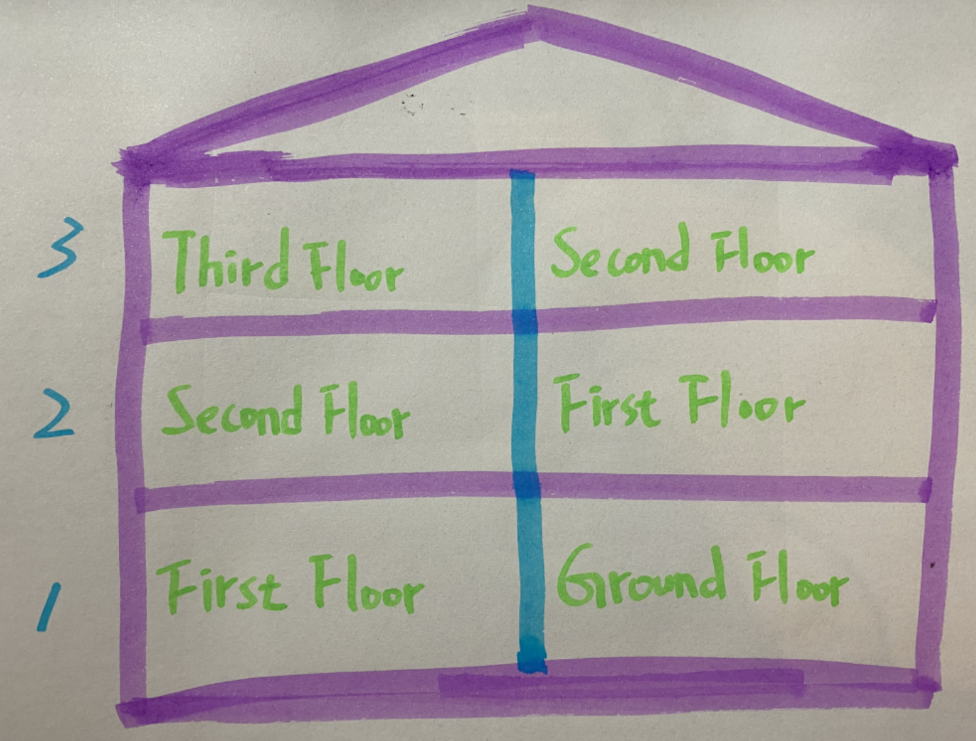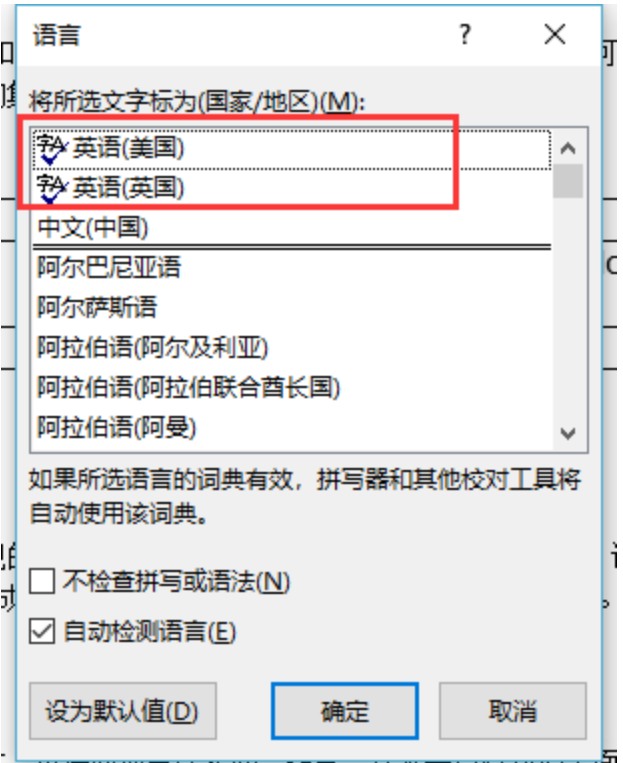C7.1 英式美式英语区别¶
英语有英式英语和美式英语。虽然不同的地方很多,但是都是一些比较小的不同,一般不会影响大家对某个单词或词组的意思理解。
如果你是第一次去英国,会发现英国的楼层叫法不太一样,特别是在按电梯的时候,电梯里的按钮和国内也不一样的,同时也和美国不一样,这不一样的地方就被称为英式英语和美式英文。
如下图,左边的就是美式英语的一楼、二楼和三楼,而右边就是英式英语里的一楼、二楼和三楼,注意看,在英式英语里的一楼叫Ground floor,也就是临近地面的楼层的,和我们平时熟悉的一楼是不一样的,也就是说在英式英语里First floor就是美式英语里的二楼,而美式英语的二楼叫Second floor。

大家一定很奇怪,这个是为什么呢?怎么英语还有什么英式英语和美式英语。
据说其中一个原因,这是在19世纪第一批英语词典编纂时的一种有意识的决定,美式英语词典编纂的时候,简化了一些单词和根据自己的观点进行编写的单词,从而区别了英式和美式英语,也建立了略有不同的语言形式。
特别是一名叫Noah Webster的美国人在当时认为“u”没有必要,是多余的,而且也有点过时,所以为了美式英语更独特一点,以另一种风格来说英语,形成专门属于自己的语言,Noah Webster就在他的字典里将单词里面多余的“u”去掉,并把“re”换成了“er”,比如美式英语的“中心”的写法就成了“center”,而在英式英语里面“中心”是"centre",比如“theater”和“theatre”等等。
然后就是随着时间的演变,慢慢的有些英语用法也会逐渐跟着使用习惯等等改变,例如“needn’t”在英式英语中比较常用,但在美式英语中却很少用到,美式更倾向于用don ' t need to。
不管是英式英语还是美式英语,这两种语言都是正确的,不管是单词的拼写还是用法,都是可以使用的,一般来说英式英语是英国口语和书面语的标准方言。虽然两种都可以使用,但是要注意,在写论文或笔试考试的时候一定不要将英式英语和美式英语混写,这样会扣分,也就是说如果通篇用了英式拼写法,那么就不要用美式写法了。
那么美式英语和英式英语具体有哪些区别呢?
1、发音不同
其实任何语言在不同地区都可能有不同的口音,也就是发音都会有一点不同,但是基本上一般不会影响英语交流。而英式发音的一些关键的特征是把“TH”发成“F”,把“H”省略在单词的开头(比如用“oliday”代替“Holiday”)。伦敦人的说话方式也使用了一种精心设计的押韵俚语。美国人通常会发一个单词中的每个“r”,而英国人往往只发单词的第一个字母“r”。
2、拼写不同
中文 | 英式英语 British English | 美式英语 American English | 拼写规则 |
颜色 | colour | color | our → or |
荣誉 | honour | honor | our → or |
劳动 | labour | labor | our → or |
中心 | centre | center | re → er |
剧院 | theatre | theater | re → er |
米/公尺 | metre | meter | re → er |
旅行 | travelling | traveling | ll → l |
顾问 | counsellor | counselor | ll → l |
辩护 | defence | defense | ence → ense |
执照 | licence | license | ence → ense |
目录 | catalogue | catalog | ogue → og |
对话 | dialogue | dialog | ogue → og |
识别 | recognise | recognize | ise → ize |
组织 | organise | organize | ise → ize |
分析 | analyse | analyze | yse → yze |
实践(名词) | practice | practice | ce/ se 统一 |
实践(动词) | practise | practice | ce/ se 统一 |
百科全书 | encyclopaedia | encyclopedia | ae → e |
儿科 | paediatric | pediatric | ae → e |
飞机 | aeroplane | airplane | aero → air |
支票 | cheque | check | que → ck |
灰色 | grey | gray | ey → ay |
3、词汇差异
British English 英式英语 | American English 美式英语 | 例句 | |
交通出行 | |||
汽油 | petrol | gas / gasoline | I need to fill up with petrol/gas. |
高速公路 | motorway | highway/freeway | Take the motorway/highway to London. |
后备箱 | boot | trunk | Put the luggage in the boot/trunk. |
引擎盖 | bonnet | hood | Check the oil under the bonnet/hood. |
卡车 | lorry | truck | A long lorry/truck passed by. |
地铁 | underground / tube | subway | We took the tube/subway to the city center. |
人行道 | pavement | sidewalk | Don't cycle on the pavement/sidewalk. |
斑马线 | zebra crossing | crosswalk | Cross at the zebra crossing/crosswalk. |
日常生活 | |||
公寓 | flat | apartment | I rent a flat/apartment in the city. |
电梯 | lift | elevator | Take the lift/elevator to the 5th floor. |
一楼 | ground floor | first floor | 英式的一楼是美式的二楼 |
垃圾 | rubbish | trash / garbage | Throw it in the rubbish/trash bin. |
垃圾桶 | rubbish bin | trash can | Please throw the empty bottle in the trash can/ rubbish bin |
水龙头 | tap | faucet | The tap/faucet is dripping. |
手电筒 | torch | flashlight | You'll need a torch/flashlight at night. |
排队 | queue | line | We had to queue/line up for tickets. |
假期 | holiday | vacation | We're on holiday/vacation. |
食物餐饮 | |||
薯条 | chips | French fries | I'd like fish and chips/French fries. |
薯片 | crisps | chips | A bag of crisps/chips. |
饼干 | biscuit | cookie | Would you like a biscuit/cookie? |
糖果 | sweets | candy | Eating too many sweets/candy is bad for your teeth. |
开胃菜 | starter | appetizer | For starter/appetizer, I'll have the soup. |
外卖 | takeaway | takeout | Let's get a takeaway/takeout tonight. |
茄子 | aubergine | eggplant | I bought a fresh eggplant/ aubergine |
西葫芦 | courgette | zucchini | I'm growing zucchini/courgettes in my garden |
服装穿搭 | |||
裤子 | trousers | pants | He wore blue pants/ trousers. Pants英式=内裤;美式=裤子 |
内裤 | pants/ underpants | underwear | He bought new underwear/ underpants |
套头衫 | jumper | sweater | She was wearing a blue jumper/sweater. |
运动鞋 | trainers | sneakers | I bought a new pair of trainers/sneakers. |
背心 | waistcoat | vest | It's just a plain white vest/ waistcoat. Vest英式 = 汗衫/内衣;美式=穿在西装外的马甲 |
尿布 | nappy | diaper | The baby needs a clean nappy/diaper. |
其他常用 | |||
电影 | film | movie | Have you seen this film/movie? |
电影院 | cinema | movie theater | Let's go to the cinema/movies. |
足球 | football | soccer | He loves playing football/soccer. |
简历 | CV | resume | Please send us your CV/resume |
橡皮 | rubber | eraser | Can I borrow your rubber/eraser? 在美式英语中,rubber 口语上一般意思是避孕套。 |
时间表 | Timetable | Schedule | Check the train timetable/ Schedule |
创可贴 | plaster | Band Aid | She put a plaster/ Band Aid on the cut. Band Aid 是品牌名,已被广泛使用。 |
4、介词不同
中文 | 美式英语 American English | 英式英语 British English | 例句对比 |
时间(周末) | on the weekend | at the weekend | 美:What are you doing on the weekend? 英:What are you doing at the weekend? |
时间(一段时间) | through Friday | till/to Friday | 美:I'll be away through Friday. (直到周五结束) 英:I'll be away till Friday. (直到周五) |
地点(在团队里) | on a team | in a team | 美:She's on the soccer team. 英:She's in the football team. |
地点(在街上) | on the street | in the street | 美:I saw him on Main Street. 英:I saw him in the High Street. 美式也用 "in the street" 指"在马路中央"。 |
地点(写信给) | write to someone | write someone (省略to) | 美:I'll write to you soon. 英:I'll write you soon. 美式两种都可,但 "write to" 更正式。 |
时间(周一至五) | Monday through Friday | Monday to Friday | 美:The office is open Monday through Friday. 英:The office is open Monday to Friday. |
其他(与…不同) | different from | different from/to | 美:You look different from your sister. 英:You look different to your sister. 美式 "different than" 也很常见。 |
其他(填表) | fill out a form | fill in a form | 美:Please fill out this application. 英:Please fill in this application. |
其他(见面) | meet with someone | meet someone | 美:Let's meet with the clients. 英:Let's meet the clients. |
5、一般过去时和现在完成时
美式英语 American English | 英式英语 British English | ||
拥有/关联 | I lost my key. | I've lost my key. | 英式:钥匙丢了,现在还没找到,影响了现在(进不去门)。 美式:常用一般过去时描述这个事实。 |
经历 | Did you eat yet? | Have you eaten yet? | 英式:"你吃过了吗?" 关心的是你现在是否饿。 美式:"你(刚才)吃了吗?" "Did you eat?" 非常普遍。 |
刚刚发生 | He just arrived. | He has just arrived. | 英式:必须与 "have" 连用。 美式:"just" 常与一般过去时连用。 |
副词 "already"/"yet" | I already saw that movie. | I have already seen that movie. | 英式:这些副词通常与现在完成时连用。 美式:常与一般过去时连用。 |
6、get的过去分词
美式英语American English | 英式英语British English | |
gotten (常用) | got (几乎唯一形式) | |
表示"获得/得到" | I've gotten a new car. (我得到了一辆新车。) | I've got a new car.(我得到了一辆新车。) |
表示"拥有" | I've got a new car. (我有一辆新车。) | I've got a new car.(我有一辆新车。) |
表示"变得/成为" | It has gotten much colder. (天气变得冷多了。) | It has got much colder. (天气变得冷多了。) 但更常用:It has become much colder. |
表示"必须" | I've got to go now. (我必须走了。) | I've got to go now. (我必须走了。) |
7、集合名词,单数还是复数
名词类型 | 中文 | 美式英语 (视为单数) | 英式英语 (常视为复数) |
集合名词 | 团队 | The team is playing well. | The team are playing well. |
公司 | Apple has released a new phone. | Apple have released a new phone. | |
政府 | The government is debating the law. | The government are debating the law. | |
家庭 | My family is large. (指整体) | My family are lovely. (指家人们) | |
机构名称 | 乐队/组合 | Coldplay is on tour. | Coldplay are on tour. |
运动队 | England is a strong team. (指队伍实体) | England are winning the match. (指场上队员) |
8、规则动词还是不规则动词
动词原形 | 中文 | 美式英语 | 英式英语 | |
learn | 学习 | learned | learned / learnt | 美式只用 ed 结尾。英式 ed 和 t 结尾通用,但 t 结尾更传统常见。 |
burn | 燃烧 | burned | burned / burnt | 同上。 |
dream | 做梦 | dreamed | dreamed / dreamt | 同上。 |
spell | 拼写 | spelled | spelled / spelt | 同上。 |
spill | 溅出 | spilled | spilled / spilt | 同上。 |
smell | 闻 | smelled | smelled / smelt | 同上。 |
dive | 跳水 | dived / dove | dived | 这是少数美式英语更不规则的例子。美式英语中 dove 非常普遍。英式英语几乎只用 dived。 |
get | 得到 | gotten (作为过去分词) | got | 这是最著名的区别之一。美式英语用 gotten 表示"得到"或"变得",用 got 表示"拥有"。英式英语在所有情况下都用 got。 |
quit / fit | 退出 / 适合 | quit, fit | quitted, fitted | 美式英语倾向于使用不规则形式(与原形同形)。英式英语则使用规则的 ed 结尾。 |
总之就是作为世界上使用最多的第二语言,英语是灵活多变的,有很多国家都说英语,所以会有很多种口音,也会随着时间和一些情况的改变,英语也会随之改变。
所以无论英式英语还是美式英语,都是可以交流的,只是在书写的时候需要注意一下即可,现在的word都是有自动检测是英式英语还是美式英语,如果你想写英式就选择英语(英国)即可,反之也是可以选择英语(美国),分别代表的就是英式英语和美式英语,如下图:
